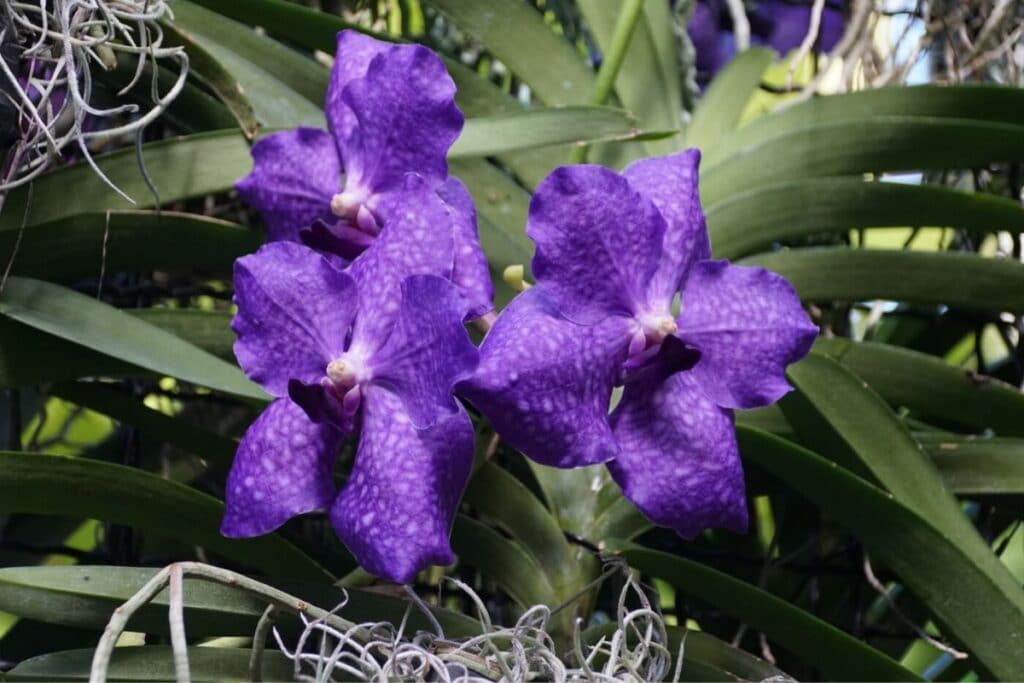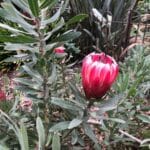The family of orchids is so diverse that many species, hybrids, and types are readily available throughout the globe. Their unique yet exquisitely beautiful flowers, for one, make them a popular ornamental for in gardens and floral shops. The genus Vanda is no exception.
Although it is relatively not as huge as other orchids, the Vanda genus is one of the most horticulturally important types of orchids because of their flowers’ high ornamental values.
Vanda orchids are well-recognized both as cut flowers and houseplants. Extremely hybridized, they have contributed much to the work of plant breeders in producing notable orchid hybrids that come in different vibrant colors and sizes.
Facts About Vanda Orchids
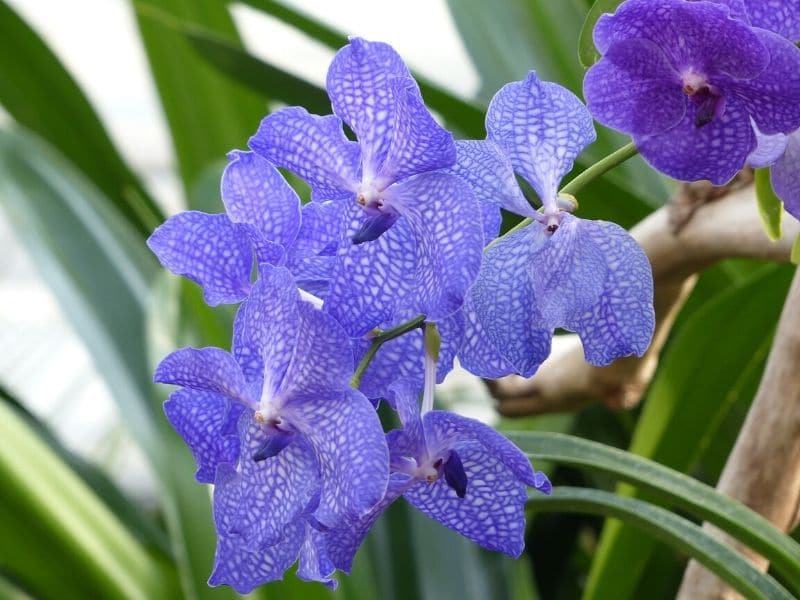
Vanda originates from the same Sanskrit name given to Bengal orchids. Today, the name refers to an entire genus in the Orchidaceae family.
Vanda orchids (Vanda spp.) are native to Southeast Asia (1) and can be found in various parts of the world from East Asia to Australia. Sometimes it is referred to as Singapore orchid.
The genus has over 50 recognized species and thousands of hybrids in varying flower colors, including purple, yellow, brown, red, and blue. Famed Vanda hybrids include the following: ‘Nelly Morley,’ ‘Blaue Donau,’ ‘Onomea,’ ‘Rose Davies’, and ‘Rothschildiana.’
Plant Description
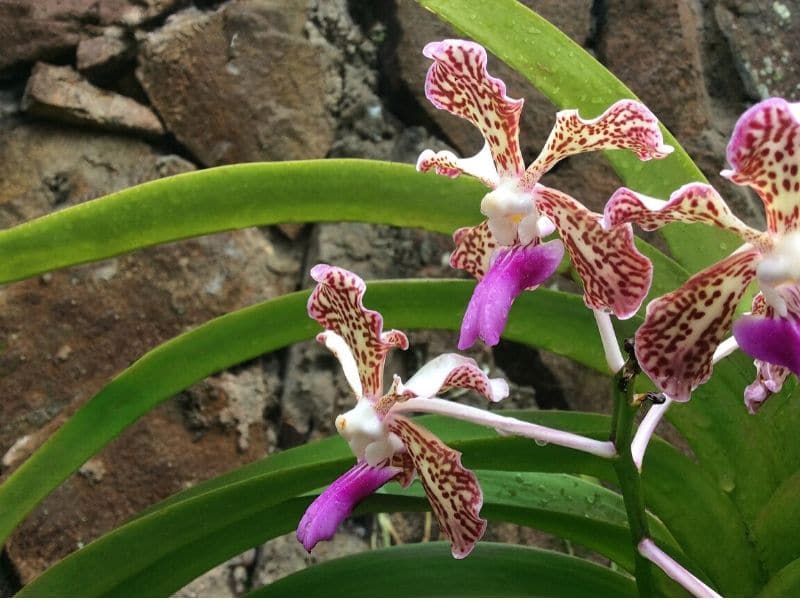
Generally, Vanda orchids are monopodial epiphytes (1), but some species are lithophytes or terrestrial. They have aerial roots and long, sturdy, and upright stems. Some species can reach up to a height of 6 ft, but most Vanda orchids have a compact growth habit.
The leaves of these orchids vary depending on the habitat. Some species, categorized as strap-leaved Vanda orchids, have strap-like leaves that are leathery and thick.
Terete Vanda orchids have cylindrical, fleshy leaves. Other species, classified as semi-terete Vanda orchids, have intermediate leaf form between strap-leaved and terete Vanda types. Of these three, terete Vandas are more adapted to dry periods.
The flowers of Vanda orchids are flat and recognized for a short spur on the lip. They are often fragrant and bloom more than once a year on a lateral inflorescence. The flowers typically last for two to three weeks in spring and fall.
Popular Vanda Orchid Species
Vanda coerulea
Common Names: Blue Orchid, Blue Vanda, Autumn Lady’s Tresses
A popular species of Vanda orchids, if not the most, is the V. coerulea or the Blue Orchid. This type of Vanda is highly valued for its blue flowers, especially since blue is not as common as other orchid flower colors. Because of its uniqueness, this plant is often used in producing interspecific and intergeneric orchid hybrids.
V. coerulea is a medium to large-sized orchid native to Myanmar, Thailand, Northeast India, and southwest China. Each plant reaches about 75 cm long and 50 cm wide and produces up to 30 long-lasting flower spikes. The leaves grow up to 25 cm long and 2.5 cm wide.
Vanda coerulescens
Common Name: Sky Blue Vanda
The Sky Blue Vanda (V. coerulescens) is a compact orchid species found in India, eastern Himalayas, Myanmar, Thailand, and Yunnan in China at elevations of 300 to 800 m. This monopodial epiphyte grows up to 15 cm in height.
It commences flowering in winter to spring with about 12 to 20 lilac-blue flowers per inflorescence. Each flower, which has a darker indigo blue lip, is fragrant and measures about 3 cm.
Vanda tessellata
Common Names: Checkered Vanda, Lattice- Like Patterned Flower Vanda
The Checkered Vanda, V. tessellata, is a medium- to large-sized orchid species that originated in India and recognized for its medicinal value. This orchid plant can grow up to 1 m in height with long and linear leaves that measure up to 20 cm.
The fragrant and long-lasting flowers, which bloom on a sub-erect inflorescence, have yellow petals with brown and white markings, yellow tessellated sepals, and bluish-purple lip. Flowering occurs in the summer, fall, and early winter.
Vanda sanderiana
Common Names: Waling-waling, Sander’s Vanda
Waling-waling is another popular species of Vanda orchids. It is native to the Philippines, where it is highly recognized for its ornamental value and known as the “Queen of Philippine flowers.” It is also known as the “King of Vanda” because of its contributions to many Vanda hybrids (3).
The other common name, Sander’s Vanda, is a nod to notable orchidologist Henry Frederick Conrad Sander by Professor Reichenbach (3).
This large-sized Vanda orchid often grows on tree trunks at elevations below 500 m. The leaves can measure up to 40 cm long. Oldest leaves are deciduous.
Waling-waling flowers are fragrant and long-lasting. They bloom in the fall and usually measure about 9 cm to 11 cm wide. The outer whorls are rounded while the internal whorls are smaller. The lip is relatively small, concave, and commonly brown-yellow with hints of red streaks on the inside.
Three recognized varieties of the V. sanderiana are the V. sanderiana var. albata, V. sanderiana var. froebeliana, and V. sanderiana var. labello-viridi.
Vanda tricolor
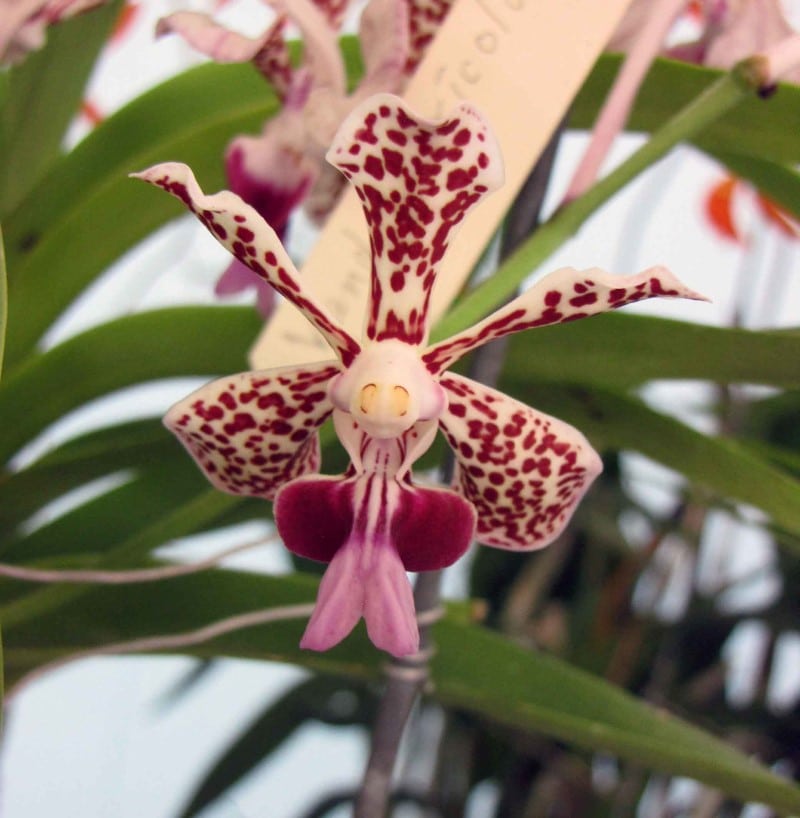
Common Names: Soft Vanda, Three-Colored Vanda
Commonly found in Laos and Indonesia, particularly in Java and Bali, is a species of Vanda orchids known as the Vanda tricolor or the Soft Vanda or Three-Colored Vanda. Its distribution also extends to northern Australia (3). It was brought to England by British Botanist Thomas Labb in 1846.
The Soft Vanda is a large-sized orchid that grows on exposed branches of trees. The leaves are about 35 cm to 45 cm long and 4 cm wide, leathery, and striped. 6 to 10 large, waxy, and fragrant Soft Vanda flowers bloom in the fall and winter on curved inflorescence for weeks. They can grow up to 7.5 cm in diameter.
Two of the most known varieties of this Vanda orchid are the var. tricolor and the var. suavis.
Vanda Orchids Care And Grow Guide
Vanda orchids grow from thick and fleshy pseudobulbs that store moisture and energy necessary for growth and flowering. When grown in the right conditions, Vandas will produce beautiful and often fragrant flowers.
Light
Light plays an important role when growing a Vanda orchid plant. There are three general types of this species classified depending on their leaves: strap-leaved, semi-terete, and terete Vandas.
Terete Vanda orchids have cylindrical and fleshy leaves that require bright light but will not thrive well in full sunlight. They are substantially more resistant to direct sun than other orchids.
Provide 25 to 35 percent shade to plants in a greenhouse, less in the winter with cloudy weather. The leaves should be a medium green rather than a dark green.
Vandas with strap-like leaves, on the other hand, need partial shade and protection from high light. Semi-terete Vanda orchids fall somewhere between the two types. They have an intermediate leaf shape.
Temperature and Humidity
This orchid group is heat-loving and endemic to tropical Asia. Most Vanda plants thrive best under temperatures between 55 degrees F to 95 degrees F. The ideal night temperatures are between 60 degrees F to 70 degrees F.
They can tolerate cooler temperatures for a short time as long as it is not windy. Exposing the plant to any temperatures below 50 degrees F can result in delayed flowering.
Vandas thrive at high humidity levels ranging from 50% to 70%.
Water
Proper watering is another vital factor in growing an orchid plant successfully (2). This species of orchids enjoy a sufficient amount of water, primarily if grown in slotted baskets where their roots freely dangle toward the ground. It is crucial to keep the plants moist but not soggy to avoid rot.
Ideally, water Vanda orchids twice a day if the temperature is high. Reduce the frequency of watering during winter months.
If the vanda orchid is grown in a container that is put in a warm, sunny location, the plant may require daily watering or misting.
Fertilizer
Generally, orchids respond well to regular feeding, but too much application of fertilizer may do more harm than good (2). Vanda orchids are heavy feeders and grow best if provided with a balanced fertilizer. Fertilize with a balanced fertilizer (such as 20-20-20) applied full strength once a week during warm weather or the growing season, or use a one-quarter-strength solution at each watering.
Remember: Apply fertilizer every two to four weeks during chilly or gloomy weather.
Potting and Growing Media
Vanda orchids grow best when grown in well-draining media, such as fern fibers, coarse fir bark, or sphagnum moss. If the potting medium breaks down or becomes waterlogged, you will need to re-pot your Vanda orchid. Repotting these orchids should be done every three to five years in spring.
FAQs
What is the difference between orchids and Vanda?
Vanda is a specific genus within the orchid family, Orchidaceae. While all Vandas are orchids, not all orchids belong to the Vanda genus. Vanda orchids are known for their vibrant colors, large size, and aerial root growth.
Are Vanda orchids difficult to grow?
Vanda orchids can be challenging for beginners due to their specific care requirements. They thrive in warm, humid conditions, need bright light, and benefit from a well-ventilated environment, making them more suitable for experienced orchid growers.
References
Reference list
- Aggie-horticulture.tamu.edu. (2020). Orchidaceae or Orchid Family. [online] Available at: https://aggie-horticulture.tamu.edu/syllabi/302/new/family/orchidaceae.html
- Web.extension.illinois.edu. (2020). Growing Orchids. [online] Available at: https://web.extension.illinois.edu/hortihints/0204d.html
- Teoh, E., 1995. Orchids Of Asia. Singapore: Times Books International.
Close
*Photo by khairil77/depositphotos

